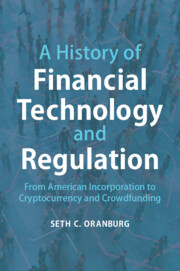 A History of Financial Technology and Regulation
A History of Financial Technology and Regulation from The Third Era
Published online by Cambridge University Press: 24 March 2022
The sharp and rigid dichotory between public and private corporations is a hallmark of securities regulation, but it has become outdated. The recent emergence, and dominance, of large private companies—once called “unicorns” for their rarity but now numbering in the hundreds—undermines essential assumptions behind securities regulations. This Chapter explores how the rise of these gargantuan private companies was brought on by the public’s eroding confidence in public companies and exacerbated by an ill-equipped government producing ineffective, reactionary legislation. Specifically, the Penny Stock Reform Act of 1990 and the Sarbanes-Oxley Act of 2002 resulted in a muddied pool of legitimate and fraudulent investment opportunities. Ordinary investors were left clambering for new investment opportunities and have shifted their gaze to the wilderness of the unregulated cryptocurrency market.
To save this book to your Kindle, first ensure no-reply@cambridge.org is added to your Approved Personal Document E-mail List under your Personal Document Settings on the Manage Your Content and Devices page of your Amazon account. Then enter the ‘name’ part of your Kindle email address below. Find out more about saving to your Kindle.
Note you can select to save to either the @free.kindle.com or @kindle.com variations. ‘@free.kindle.com’ emails are free but can only be saved to your device when it is connected to wi-fi. ‘@kindle.com’ emails can be delivered even when you are not connected to wi-fi, but note that service fees apply.
Find out more about the Kindle Personal Document Service.
To save content items to your account, please confirm that you agree to abide by our usage policies. If this is the first time you use this feature, you will be asked to authorise Cambridge Core to connect with your account. Find out more about saving content to Dropbox.
To save content items to your account, please confirm that you agree to abide by our usage policies. If this is the first time you use this feature, you will be asked to authorise Cambridge Core to connect with your account. Find out more about saving content to Google Drive.